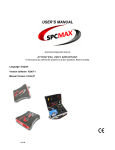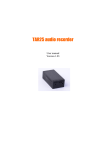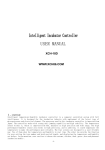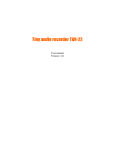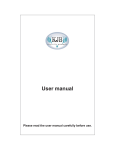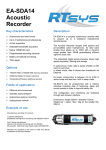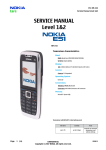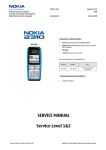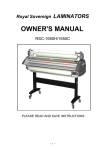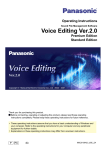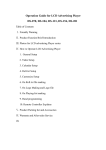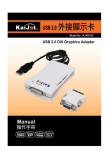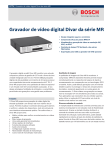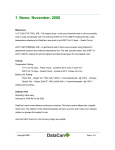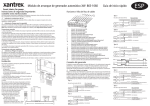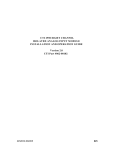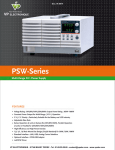Download LR32 audio recorder module
Transcript
LR32 audio recorder module User manual Version 1.03 This recorder let‘s you to record any audio or human conversation in high quality and store all on micro SDHC card. The state of art technology with very low power consumption allows you to record very long records when the battery is powering the module. This recorder is equipped with very high sensitive microphone and wide dynamic range and is able to record conversation from distance over 30 feet (10 meters). All stored recordings are accessible on micro SDHC card by using included recording manager developed for Windows operating system. This software includes fast overview of each record and simple editing functions, including serach for active sound in long records. For protection of stored data it is possible to set password access for all stored recordings. Integrated real time clock should start recording in any specific period of each day or at any specific date. All recorded data are stored with time marks, which gives you very good overview in case of long time recording. Technical data: Dimension: Power supply voltage: Maximum recording time: Card type: Signal-to-noise ratio: Storage format: Sample rate: Bit width: Built-in microphone sensitivity: Power consumption in stand-by mode: Power consumption in VAS mode: Voice activated recording AGC function Exporting format: Scheduled recording: Operating mode select: 17,5x27x3mm 3,0-6,0V over 70days (with 16GB card) Micro SDHC card 65dB 16bit uncompressed, logaritmic, 4bit ADPCM or 2bit ADPCM 44kHz, 22kHz, 16kHz, 11kHz, 8kHz, 5.5kHz 16bit 8-10m <50uA 1,6mA at 3,0V yes user selectable automatic gain control or fixed microphone gain by using included software, WAV format selectable daily period, week period or calendar slide switch Module description Power consumption in different recording modes based on 3.0V voltage supply in [mA]: Sample rate 5,5kHz 8kHz 11kHz 16kHz 22kHz 44kHz none Ulaw 2,0mA 2,6mA 3,2mA 4,0mA 5,8mA 10,6mA 1,85mA 2,6mA 3,1mA 3,47mA 4,3mA 6,5mA 4bit ADPCM 1,6mA 1,7mA 1,8mA 2,4mA 2bit ADPCM 1,6mA 1,7mA 1,7mA 2,2mA The current is calculated when the 3,0V voltage is used. When you have a higher voltage or for example 6,0V batteries, the consumption is decreased with the increasing voltage in proportional way. B attery life for different operating modes in continuous recording mode with CR-123 type battery [in days]: Sample rate 5,5kHz 8kHz 11kHz 16kHz 22kHz 44kHz none uLaw 18days 12days 10days 7days 5days 3days 29days 21days 18days 16days 11days 5days 4bit ADPCM 33days 24days 20days 17days 2bit ADPCM 33days 32days 27days 24days For extending battery life should be used voice acitivated recording mode. This option may extend this time significantly. Operating instructions For controlling all functions is used one slide switch and multifunctional LED. Before using the recorder you must have ready formatted SDHC card with FAT32 file system. Card must be formatted with FAT32 file system only and can’t contain any other files or folders, than image files, created by the recorder and can’t be used by other equipment, like PDA, digital camera, etc... When the card is used for the first time and doesn't contain any files, the recorder will first create all image files required for the recording. This process will start after you insert the card and turn the slide switch to ON. The LED will start flashing quickly for approximately 2 minutes (depending on a card size, for 32GB card could be a longer time). When it's done, the normal recording will start. Each card contains one or several files named “rcimage.raw”, “rcimage.ra1”, etc. All those files are used by the Record Manager to open your records. Each audio record is stored into those files and no other separate file will appear on the card. Do not remove or insert the card, when the recording or the initial card formatting is in progress. Start and stop the recording This action is operated by using a slide switch. The slide switch works in parallel with the internal timers for scheduled recording. For example, when the slide switch is in ON position, the recording is not interrupted regardless the settings of scheduled recording. When the timer activates the recording, it still continues until the scheduler reaches the scheduled stop time regardless the position of slide switch. Before the recording starts, the LED flashing sequence will follow. When the LED flashes 5 times, it means some failure and the recording didn’t start. When it flashes only ones, the card is full and recording can’t be started. Flashing 2 to 4 times indicates available memory space. (4 flashes – more than 75% space available, 3 flashes – more than 50% space available, 2 flashes – less than 25% space available). The recorder should store up to 255 records. If this count has exceeded, the card is considered as full. When the recording is in progress, the LED makes short flashes each 2 seconds. This function should be disabled for discrete recording. When the voice activated recording is enabled, the LED flashes only, when the sound level is above selected threshold and recording is in progress. The recording is stopped when the card is full or by moving the slide switch to OFF position. Stop sequence is indicated by 3 LED flashes. Power supply for recorder The recorder should be powered with any power source giving the voltage in a range of 3,06,0V. Do not exceed the 6,0V limit, this may significantly damage the recorder. The recorder should be powered by small coin cell batteries with any chemistry (Zinc-Air batteries gives the longest recording time in comparing the smallest size). The small coin cell non rechargeable batteries may not provide sufficient current during a write cycles to the SD card. For this case connecte the batteries in a series to provide a higher voltage (but not over 6,0V in total) and select the recording mode with a less power consumption. Types of supported SDHC cards The recorder supports a wide range of micro SDHC cards, however we recommend you to use our included card for best performance. The cards from the other brands should consume more power and this should affect the power consumption significantly in recording mode. Maximum supported card size is 32GB. Record Manager The software Record Manager is used for handling all records and configuration of the recorder. All funcions are described in a separate manual for this application. This software is a common application used for all of our recorders and only a configuration (or only a part of the configuration) is a specific part for each recorder type. This part is described below. Before you start changing the configuration, keep in mind all the configuration is stored on microSD card. The recorder will use the new configuration only when the card is inserted back to the recorder and the recorder starts the recording. This is important for the scheduled recording or a real time clock settings to first activate the recording by using a slide switch. This action will not only activate the recording, but it will load the new configuration into the recorder, including the real time synchronization, when it has been saved in a configuration. All configuration is stored in image file on microSD card. The configuration should be changed in main menu by selecting „Options -> Recorder settings“. This windows is divided into 4 following sections: The first general part is used to select recording sample rate and compression method. To achieve the best quality you should use 16kHz or 22kHz without compression, but this mode takes the most power from the battery and will use most of the space for storing the data. For best performance check table showing battery life and memory capacity for each specific mode. Using ADPCM 2bit compression results in worst audio quality. Audio page is used for voice activated recording. When this option is enabled, recorder is recording only when it detects sound above selected threshold level. Minimum level means the highest sensitivity. Delay is specifying the time, for how long recording continues after this sound level is not detected anymore. Recommended value is 5 seconds or more. When LED is enabled to flash during recording, it is flashing only when recording is in progress and not when the recorder is in idle mode waiting for exceeding the selected threshold level. This mode saves significantly the battery energy resulting much longer time of operation. For microphone volume control is implemented AGC function. The recorder should be used in noisy environment or to monitor large rooms, where all silent sounds are required to be recorded. When AGC checkbox is checked, this function is enabled and recorder automatically adjust microphone volume according detected sound level. Maximum microphone volume indicates the maximum volume used by AGC function. When AGC function is disabled, this selected volume is fixed for all the time. Recorder is equipped with internal real time clock and recording scheduler. If you want to use time activated recording, you can choose from 3 options. Daily timer enables recording scheduler to start and stop recording at the specified time period, which repeats every day. Single timer is used to start and stop only once at given time and date. The last is weekly timer, where you can specify a different time periods for each day of a week. Every time set to 00:00 is ignored, which enables to schedule recording for example over the midnight. The last part of a configuration contains various options. LED should be disabled in this window to allow discrete mode of operation. This disables flashes during recording. Indication of power up, start and stop sequence is not affected by this option. The real time clock is synchronized according the preset time stored on microSD card. When you select in this window power-up date and time, this date and time is synchronized inside the recorder when the card is inserted into a recorder and the switch is moved to ON position. The check box “Set time” must be checked for internal clock synchronization. The recorder will load the preset time only the first time, when the same card is inserted into the recorder and the switch is moved to ON. The same effect is when you insert the card and the recorder is not connecterd to a power supply and you will connect the power later. At this time it's not necessary to move the slide swith and the new time and configuration is always used at the time when the power supply is connected. If you want to set the internal clock again, you must repeat the procedure above by saving a new configuration on the card with the new preselect time. All recordings should be password protected by using password protection. It is recommended to verify the correct clock settings inside the recorder before you decide to use scheduled recording. After you set the time in the recoder according the described procedure, make a short record manualy by using a slide switch and then remove the card and open Record Manager and check this record. The time stamp of this record must match the real time, when it has been recorded. Password protection and audio files encryption For LR-32 PRO version is a different password protection method. All records are encrypted by using the password in the recorder settings. When the password protection is enabled and the password is entered, all new recorded audio will be encrypted by using this password. When you open the image file, all encrypted records will be displayed in a red color in the list. Please note, when you’ll change the password again, all previously stored records are still encrypted with the previous password. When you want to replay the record or export it, you’ll be asked to type the password, which has been used at the time, when this audio record has been made. FAQ: Q: Can’t start recording – LED flashes only once and the card is not full. A: The card contains 255 records. For next recording you must delete at least last record from the list or format the card. Q: Card can’t be initialized, LED always flashes 5 times. A: Card is not micro SDHC type or is not properly inserted or the power supply can’t give sufficient current to initialize the card. Q: The beginning time of recording is incorrect or scheduled recording is not working A: This time is always equivalent to the real time clock, which are synchronized from the card. This problem should happen, when the power was disconnected. You must sychronize the time again. Q: Recorder was operating and the power source has been suddenly interrupted. A: For this case the last record will be stored properly without any problems. Q: The image file is missing on the card, or the card is unreadable in PC computer or the image file was deleted. A: In this case never try to recover the date by using any data recovery software and consult this problem with your distributor of recorder. All the data should be recovered, but recorder is using specific way to store the data and special procedure must be used for this case. Q: Recorded sound is distorted in very loud sequences. A: Enable AGC function in recorder’s settings to prevent microphone overloading by loud sounds. Avoid using ADPCM2 compression, if you require good quality of audio.









